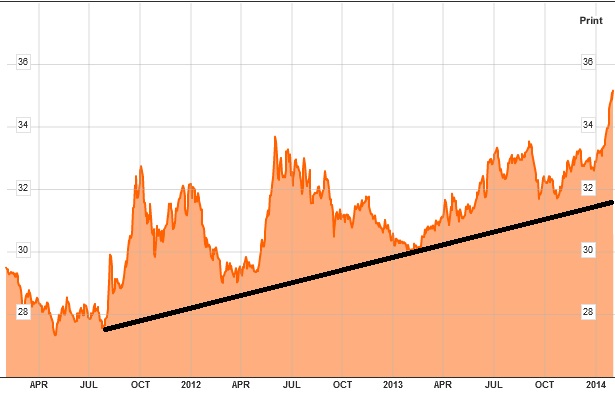As all eyes turn and focus on the upcoming XXII Winter Olympic Games about to open in Sochi, Russia, it seems appropriate for a topical take on how the Russian Ruble fits into the Forex world.
Russia, despite being the core of one of the world’s two superpowers for half a century, has been classed as an “emerging market” since its modern incarnation began following the collapse of the Soviet Union in 1991. Emerging markets tend to be characterized by political and economic instability coupled with opportunities for foreign investment to either make spectacular returns, or sink without trace. The political and economic instabilities extend, naturally, to the country’s currency.
After twenty-three years, Russia is less of an emerging market. In many respects it was never typical, as its traditions of authoritarian rule and populist dirigisme ensured that most of the best investment opportunities were preserved for domestic rather than foreign exploitation. Following the chaos of its early years, the Russian economy has stabilized and living standards have begun to rise, although by all accounts life for the middle-class is today financially extremely harsh.
The Russian currency followed a fairly typical “emerging market” pattern during this period, falling in value during a crisis in 1998 by approximately 70%. Since then, things have become more and more stable, mirroring the development of the Russian economy as a whole.
The Ruble Today
The first thing that should be noted about the current position of the Russian Ruble is that while it can be traded freely, it is subject to frequent intervention by the Bank of Russia, which seeks to maintain the market value of the Ruble within a value band. When the Ruble approaches close to or hits the top of the band, the Bank sells U.S. Dollars and Euros to ease the pressure. Conversely, at or close to the bottom of the band, the bank buys foreign currencies with Rubles. Recently, the Bank has been selling an average of $200 million worth of currency on a daily basis, attempting to keep the Ruble stable and to smooth out volatility.
Last month, an exciting new development was announced: the Bank of Russia will stop its operations designed to support the value of the Ruble, which will make it easier to breach the upper range of the band. This saves the Bank from selling an average of $60 million of currency each day, and is a step towards a totally unsupported, free-floating Ruble which Russia is aiming to achieve at some point in 2015.
There are obvious consequences awaiting a truly free float of the Ruble. It will behave more like an “emerging market” currency, and should fluctuate with greater volatility. Analysts have noticed that the Russian authorities are probably relaxed about this prospect because they anticipate that the Ruble will continue and accelerate its trend of depreciating in value, making Russian exports cheaper. Russian wealth is largely dependent upon its exports, especially of natural resources. Therefore, many analysts conclude, it is becoming interesting to short the Russian Ruble, especially as many Forex brokerages are now including the USD/RUB within their range of pairs offered. Although the spread might typically be quite high, an “emerging market” style devaluation would be very tradable.
USD/RUB Technical Analysis
Over the past three years, the USD has been rising against the RUB. It is possible to draw a fairly straight trend line angled up directly under the lows, suggesting a healthy, long-term trend in the direction of RUB appreciation. However, it should be noted that the highs are wild, dramatic and spiky:
Photo Credits: Bloomberg
The Ruble is currently approaching its 5 year high at just over 36, which was set almost exactly 5 years ago.
Shorting the Ruble may well be a good long-term trading strategy, but its moment has probably not arrived just yet, although this direction may be given some impetus right now if the flight to safety sentiment continues to grip the markets. In the normal course of things, the USD/RUB might be expected to stall at 36 before falling. A better place to buy would be closer to the trend line, or at least following a dramatic fall from a high. This event tends to happen relatively often, as can be seen in the chart above, and should provide a good opportunity to short the Ruble against the U.S. Dollar.


